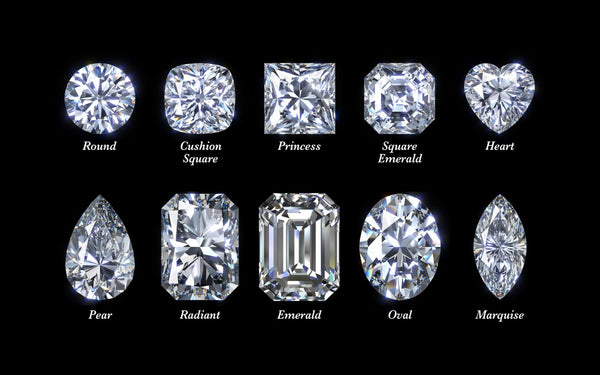Diamond Education

Every diamond is unique. Each reflects the story of its journey from deep inside the earth to a cherished object of adornment. Yet all diamonds share certain features that allow us to compare and evaluate them.
These features are called the Four C's - Cut, Color, Clarity, and Carat weight. These are the basic standards by which diamonds are graded.
CUT
The cut of the diamond refers to the shape (round, oval, emerald, etc.) and the make, geometric proportions to which it is cut. The make is the most important factor in determining how much the diamond will sparkle.
IDEAL CUT
When a round diamond is cut to perfect proportions, its depth and table percentages are perfectly balanced. The ideally cut stone also has the best grades on polish and symmetry, which can only be reached when the stone is fashioned with great care. The beauty of the stone is enhanced by the finest craftsmanship.
VERY GOOD CUT
A diamond with a very good cut has very strict requirements for depth and table percentages. These proportions give the stone a maximal brilliance and icy fire.
GOOD CUT
A diamond with a good cut has acceptable but imperfect proportions. Its brilliance and fire is good, which makes it a good stone for jewelry.
FAIR CUT
A diamond with a fair cut has less than perfect proportions to make the most of the weight. This cut sacrifices the brilliance of the stone.
POOR CUT
A poorly cut diamond has imperfect proportions that make it look lustreless. Diamonds with a poor cut are not recommended for fine jewelery.
COLOR
A diamond must be as colorless as possible. The colour grade describes the colour tones in a stone. D is perfectly colourless, which is rare and expensive. The color scale goes from D to Z and indicates yellow and brown tones. It takes a trained eye to distinguish between shades that are close together, but an untrained eye see the difference between shades that are several tones apart with a little practice. Pink, blue, red, and green diamonds are also found, but they are very rare and expensive. These fancy colored diamonds don’t follow the normal color/price scale and are priced separately.
| D | exceptionally white |
| E | exceptionally white |
| F | rare white |
| G | rare white |
| H | white |
| I-J | slightly tinted white |
| K-L | tinted white |
| M-N, O-P, Q-R, S-Z | tinted color |
CLARITY
A diamond is given a grade to describe the level of inclusions or imperfections. The fewer the imperfections, the rarer and more valuable the diamond. To determine a diamond's clarity, an expert views it under 10 power magnification. In addition to internal inclusions, surface irregularities are referred to as blemishes. These two categories of imperfections, inclusions (internal) and blemishes (external), make up clarity. Many inclusions are not discernable to the naked eye and require magnification to become apparent. A laboratory-certified clarity rating of SI-2 represents the point at which inclusions are technically not apparent to the average naked eye.
| Flawless (FL) | There are no internal or external inclusions visible under a x10 magnifying glass to the trained eye. This is the best and most expensive clarity grade. |
| Internally Flawless(IF) | There are no internal inclusions visible under a x10 magnifying glass to the trained eye. There is a minor external imperfection in the finish. |
| Very Very Small Inclusion-1(VVS-1) | Usually just one tiny inclusion, visible under a x10 magnifying glass to the trained eye. |
| Very Very Small Inclusion-2(VVS-2) | Tiny inclusions, only visible under a x10 magnifying glass to the trained eye. |
| Very Small Inclusion-1 (VS-1) | Very small inclusions, visible with a x10 magnifying glass. |
| Very Small Inclusion-2 (VS-2) | Very small inclusions, visible with a x10 magnifying glass. |
| Small Inclusions-1(SI-1) | Small inclusions, visible with a x10 magnifying glass. |
| Small Inclusions-2 (SI-2) | Several small inclusions, visible with a x10 magnifying glass. |
| Small Inclusions-3 (SI-3) | Inclusions that may be visible to a trained observer’s naked eye. |
| Included-1 (I-1) | Flaws that are visible to the naked eye. |
| Included-2 (I-2) | Many flaws that are clearly visible to the naked eye and that have an effect on the brilliance. |
| Included-3 (I-3) | Many flaws, clearly visible to the naked eye. The brilliance is decreased and the structure of the diamond is compromised: it can break or chip easily. |

CARAT
A diamond’s weight is expressed in carat, one carat being an equivalent of 200 mg. Evidently, the heavier the diamond, the more expensive. The word carat originated from the Carob tree or Ceratonia siliqua. The tiny seeds of this tree are well known for their uniformity and consistent weight. Traditionally, diamonds and gemstones were weighed against these seeds until the system was standardized, and one carat was fixed at 0.20 grams. One carat is divided into 100 points. A diamond weighing one quarter of a carat can also be described as weighing 25 points or 0.25 carats.
The carat weight of gems is not to be confused with the karat used by the goldsmith. In the case of gold, the karat is not a weight measure at all but rather a measure of quality. The higher the karatage, the higher the content of gold in the piece of jewelry. The weight can be variable.
Another "C" to consider is Certification. Here at JBDiamonds.com, we like to recommend G.I.A., A.G.S., and E.G.L. Diamond Certification to insure your diamond's quality.




